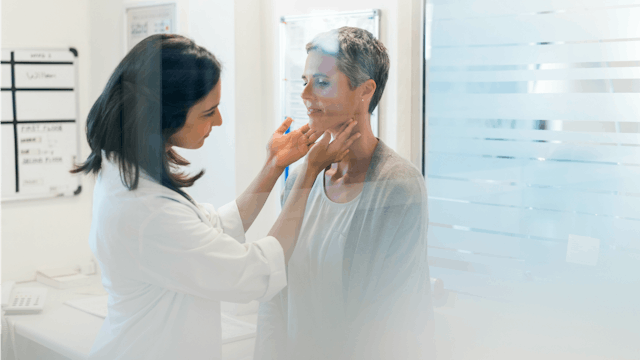What To Know About The ‘Thyroid Guard’ When You Get A Mammogram

Within a few days of each other, I saw several stories about thyroid cancer. My friend Meg, who was diagnosed with thyroid cancer a few years ago, posted a health update. Her thyroid had been removed, followed by a second surgery when it was thought that the cancer had returned. She is doing well, is healthy, and crushing life with CrossFit and Irish stubbornness.
Later that day an article popped up in my newsfeed (because I swear social media is spying on me) that stated thyroid cancer is on the rise—is the most rapidly increasing cancer in the U.S.—and effects women three times as likely as men. Another article stated that radiation was the #1 cause of thyroid cancer, and to reduce exposure, thyroid guards should be used during dental x-rays and mammograms.
This was a lot of information to dissect.
Because I am a curious person, a self-diagnosed sufferer of all things (thanks, anxiety and OCD), and am due for my first mammogram early next year, I did some investigating. Because if I don’t have thyroid cancer now, I will soon. Fine. I probably won’t, but I need to know how to advocate for my best medical health care, especially since the female DNA in my body puts me at higher risk for thyroid cancer. 3 out of 4 thyroid cancer cases are female, and most are diagnosed in their 40s or 50s.
Frances E. Carr, Ph.D., Professor, Department of Pharmacology at UVM Cancer Center, told Scary Mommy, “The rate of incidence in thyroid cancer has been 3-5% per year for the past few decades. While originally increased surveillance and better technology was thought to be the cause, it is now widely recognized and noted by the American Thyroid Association that other factors are contributing to this true increase.”
Other risk factors include low iodine levels, obesity, environmental factors, and radiation. Dr. Carr confirmed the information I saw regarding radiation being the greatest risk for thyroid cancer. However, while throat guards should be used during dental procedures, the same is not true for mammograms.
Sally D. Herschorn, MD, FACR, Vice Chair for the Patient and Provider Experience, Radiology and Professor of Radiology at the University of Vermont told Scary Mommy that thyroid guards are not protecting against anything significant during mammogram screenings. “The myth promulgated by some in the media that the increase in thyroid cancer diagnoses is due to screening mammography is not supported by evidence.”
Regarding annual mammogram screenings for ages 40-80, the ACR and Society of Breast Imaging released a statement regarding radiation received during mammography. The X-rays are scattered and the equivalent to the same as 30 minutes of natural background radiation most Americans are exposed to naturally. The statement assures those having screenings that the thyroid does not receive direct X-rays.
The risk of this minimal radiation is not high enough to risk using a thyroid guard during yearly mammograms. Unlike the guard used for dental X-rays, the guard in this case could cause shadows or interfere with ideal positioning, leading to a misleading or missed diagnosis.
While it is true that thyroid cancer is on the rise, it is also the least deadly and most survivable cancer. Some argue that because of advanced imaging tools and surveillance, thyroid cancer is being over diagnosed, with more biopsies being done and a tendency to treat a diagnosis too aggressively.
News Medical reminds people that “the risk of death from thyroid cancer is extremely low (roughly 2%) over 25 years and that risk is unaffected by the choice of procedure–total thyroidectomy or lobectomy.” Yet, as reported by doctors from The Dartmouth Institute for Health Policy and Clinical Practice and Department of Surgery, Brigham and Women’s Hospital, about 80% of patients with thyroid cancer are choosing to have their entire thyroid removed to treat localized thyroid cancer.
My friend Meg, who I mentioned earlier, said, “For me, I definitely needed it [my thyroid] removed. I had a tumor on my thyroid. My neck was enlarged. However, there are recent studies done by the Mayo Clinic that state that some thyroid cancers are lesions. I think my second surgery was bogus. I think my body just needed to sort itself out. And lymph nodes are tricky. After my second surgery, my cancer marker was elevated, but it has since calmed down.”
The most common type of thyroid cancer is papillary thyroid carcinoma (PTC); it makes up about 80% of the cases. For treatment, The American Thyroid Association recommends a lobectomy. This surgery removes one lobe of the thyroid instead of the entire gland and is recommended for people in stage I or II of papillary cancer. This is also the treatment suggested for very small or very low-risk types of thyroid cancer cases. According to Endrocrine Web, PTC has a high cure rate, and “10-year survival rates for all patients with papillary thyroid cancer estimated at over 90%.”
Cancer is scary. But not all cancers are the same. Do your research. Connect with others who have received the same diagnosis. Get the emotional support you need. And make the best decision for you.
But be aware that thyroid cancer is very treatable, and the increase in cases should not deter you from having a mammogram. Nor should the fear of it lead to asking for a throat guard during your annual breast exam and mammography screening. The levels of radiation are not greater than the risk of a more dangerous disease like breast cancer.